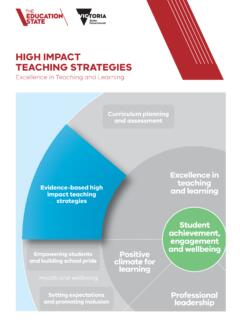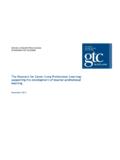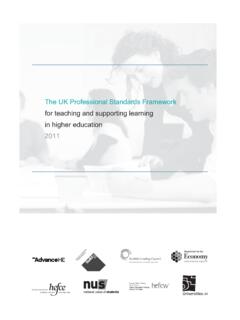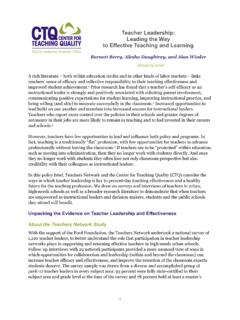Transcription of Japanese Lesson Study: Teacher Professional Development ...
1 MTED Vol 1 proof 14/11/11 7:24 AM Page 77. Mathematics Teacher Education and Development 2011, Vol. , 77 93. Japanese Lesson Study: Teacher Professional Development through communities of Inquiry Brian Doig and Susie Groves Deakin University Japanese Lesson Study has come under increasing attention from educators in the West and throughout South-East Asia since it was revealed outside Japan through the release of the TIMSS Video Study. In this paper we argue that Japanese Lesson Study provides a model for large scale, sustainable Professional Development . In particular, we draw on our own experience of Japanese Lesson Study and the research literature to describe its characteristic features and examine some of the cultural assumptions that underpin its implementation. Exploring mathematics with groups of people is inherently a cultural practice (Kazemi, Elliott, Hubbard, Carroll, & Mumme, 2007, p. 797). Japanese Lesson Study has come under increasing attention from educators in the West and throughout South-East Asia since it was revealed outside Japan through the release of the TIMSS Video Study (Stigler, Gonzalez, Kawanaka, Knoll, & Serrano, 1999) and Yoshida's doctoral dissertation (Yoshida, 1999; for a description of the study in English, see Fernandez & Yoshida, 2004).
2 Unlike many Western initiatives, richly funded and mandated, Lesson Study in Japan is neither funded nor mandatory. Essentially school-based and organised by teachers themselves, it pervades primary school education and to a lesser extent secondary school education across the country, with teachers researching their own practice in school-based communities of inquiry. This form of Professional Development is no longer restricted to Japan: mathematics Lesson Study groups have been forming in the United States for over ten years and now number more than eight hundred. In the United Kingdom there has been growing interest in, and government support for, Lesson Study as a powerful form of Professional Development (see, for example, Department for Children, Schools and Families, 2008). Lesson Study has also been introduced in South-East Asian countries such as Indonesia and Malaysia (see, for example, White & Lim, 2008), as well as South America, South Africa (Ono & Ferreira, 2010), and Australia (for example, Hollingsworth & Oliver, 2005).
3 China too has a long history of improving teaching and learning through school-based Professional learning communities named Teacher Research Groups (see, for example, Yang, 2009). While Lesson Study takes place across all curriculum areas in Japan, it is perhaps most commonly practised in mathematics, and this has tended to be the case in other countries too. Why has this form of Professional Development generated such widespread interest? Is it because it encourages teachers to develop their own communities MTED Vol 1 proof 14/11/11 7:24 AM Page 78. 78 Brian Doig & Susie Groves of inquiry into their own teaching practices? Is it because it develops effective teaching approaches? Or is it purely a cultural artefact? In this paper, we argue that Japanese Lesson Study provides a model for large-scale, sustainable Professional Development . In particular, we draw on our own experience of Japanese Lesson Study and the research literature to describe its characteristic features and examine some of the cultural assumptions that underpin its implementation.
4 Teacher Professional Development Teacher Professional Development is driven by the need to both extend and renew Teacher practice, skills and beliefs. Stimuli for such needs may be curriculum change, new classroom technology, advances in pedagogy, or all of these. However, the underlying endeavour is to improve outcomes for students, whether they be focussed on understandings, skills, attitudes, or engagement. Unfortunately, however, research evidence suggests that, despite the money, time, and effort put into Professional Development for teachers, the outcomes are not always as hoped. For example, Ingvarson, Beavis, Bishop, Peck, and Elsworth (2004), reporting on findings from a large-scale study of secondary mathematics teachers, found that the literature reviewed indicated that, much Professional Development appears to be ineffective (p. 71). Reporting on a decade-long local systemic change initiative based on Teacher enhancement, Banilower, Boyd, Pasley, and Weiss (2006) noted that Professional Development sessions designed to deepen content knowledge and support teachers' content needs during imple- mentation sometimes failed to delve into the very content they were designed to address, due to more pressing Teacher concerns such as materials management or pedagogy (p.)
5 87). Further, Darling-Hammond, Wei, Andree, Richardson, and Orphanos (2009, p. 22) suggest that, relatively few teachers engage in intensive Professional collaboration around curriculum planning . It is not surprising then, that international attention has turned to less familiar, but apparently more successful, Professional Development practices, such as Japanese Lesson Study. In searching for features of successful Teacher Professional Development , Ingvarson et al. (2004) suggest that the relationship between student outcomes and teachers' Development is reciprocal in that the more successfully students learn, the more likely it is that the Teacher will adopt practices that encourage further successful learning (p. 23). In a similar vein, Royce (2010, p. 6) argues that, what we know to be true for students also applies in this [ Professional Development ] situation to adults. That is, that teachers learn best by doing [ teaching mathematics] and building their own understandings rather than being told.
6 This resonates strongly with Guskey's (2002) re-iteration of his Model of Teacher Change where he states that, improvements typically result from changes teachers have made in their classroom practices a new instructional approach, the use of new materials or curricula, or simply a modification in teaching procedures or classroom format (p. 383). Thus opportunities to MTED Vol 1 proof 14/11/11 7:24 AM Page 79. Japanese Lesson Study: Teacher Professional Development through communities of Inquiry 79. experiment with classroom practice and analyse it in detail an important feature of Japanese Lesson Study is likely to be a fruitful path to take in Teacher Professional Development . Moreover, Hattie (2009), when looking for the characteristics of teachers who students claimed were the best, quotes Pehkonen (1992) as saying that these characteristics include teachers who helped students to have different and better strategies or processes to learn the subject (p.)
7 108), thus indicating that Professional Development that provides teachers with these skills would be of benefit to students. As discussed later in this paper, Japanese Lesson Study in mathematics is based around a structured problem-solving research Lesson , in which a major part of the Lesson consists of students sharing, polishing and refining their solution strategies. Loucks-Horsley, Stiles, and Hewson (1996), describing the results of the Professional Development Project of the National Institute for Science Education, which looked at the mathematics, science, and Professional Development communities ' understandings of what was effective Professional learning , found a large amount of consensus. For example, it was agreed, inter alia, that good Professional Development programs: are driven by a clear, well-defined image of effective classroom learning and teaching ;. provide teachers with opportunities to develop knowledge and skills and broaden their teaching approaches, so they can create better learning opportunities for students; and build or strengthen the learning community of science and mathematics teachers.
8 In this paper, we argue that Japanese Lesson Study demonstrates these features. Japanese Lesson Study Even more basic is the whole idea of instruction as something that can and should be improved through consultation with colleagues, trial in the classroom and critique. (Lewis, 2000, pp. 32 33). To the casual observer, Japanese Lesson Study may seem like a simple idea. Teachers with a common focus meet and plan lessons together. These lessons may have a focus on building skills or understanding, and are known as research lessons , which are taught by one, and observed by not only all of the teachers who are doing the planning, but also by observers who, at one end of the spectrum, may come only from the teachers' own school, or, at the other end, may come from all over Japan (see, for example, Lewis & Tsuchida, 1998). A. debriefing session follows the Lesson , where the Lesson is discussed at some length, with modifications often suggested by the observers, who frequently include an invited academic or veteran Teacher .
9 Lewis (2002) describes the Lesson Study Cycle as having four phases: goal-setting and planning including the Development of the Lesson Plan;. teaching the research Lesson enabling the Lesson observation;. MTED Vol 1 proof 14/11/11 7:24 AM Page 80. 80 Brian Doig & Susie Groves the post- Lesson discussion; and the resulting consolidation of learning , which has many far-reaching consequences (see Lewis & Tsuchida, 1998, for teachers' comments on the impact of research lessons on their understandings about science teaching ). While these points are stated simply, a great deal of unpacking of each is needed to fully understand the concepts and processes of Japanese Lesson Study in practice. Goal Setting and Planning Goal setting and planning are the critical underpinning of Japanese Lesson Study we use the metaphor of an iceberg to represent the extent of the underwater . support needed for planning the Lesson . Establishing long-term goals Long-term goals in Japanese Lesson Study may be about behaviour, attitude or learning .
10 For example, Takahashi and Yoshida (2004) give the example of a Lesson Study group in the United States wishing to investigate how to improve the teaching and learning of measurement (p. 439), while T. Fujii (personal communication, August 26, 2010) gave the example of a school whose long-term goal was to improve children's curiosity. Research themes should address the biggest gap between the qualities students have and ideals espoused by their teachers. Selecting such a theme or goal is seen to be at the heart of successful Lesson Study and can lead to a research focus that can be maintained over several years (Lewis, 2000). This aspect of Lesson Study is often overlooked when it is adopted in other countries. Planning the research Lesson In Japan, Lesson Study takes place across all curriculum areas, as well as in non- curriculum areas such as class meetings, although it is probably more common in mathematics and science than some other areas. In mathematics, the research Lesson , at least at the primary school level, usually follows the typical Lesson pattern for a Japanese structured problem-solving Lesson .



















